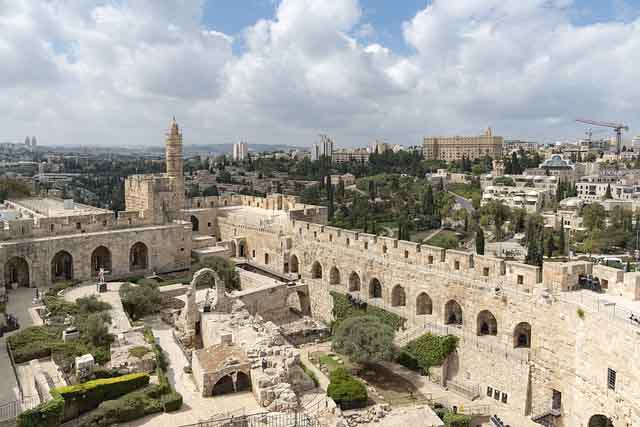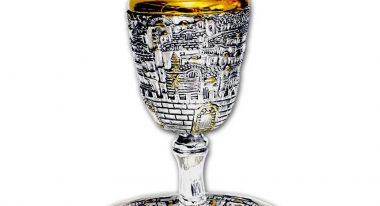
Jerusalem sites that everyone should visit.
It is impossible to write about all the attractions of the “City of God” in one article, because of their great variety. We will try to tell you about the most important ones.
The Wailing Wall
The Second Temple was destroyed by the Roman Emperor Titus in 70 CE. Only the Western Wall has survived to the present days. This wall is not a wall of the Temple – it is the remains of the support structures that were built by Herod the Great to strengthen the Temple Mount. This wall is called The Wailing Wall and it is the holiest place for religious Jews of the entire world.
This wall is called the Wailing Wall because here the Jewish people are mourning their destroyed First and Second Temples.
Dome of the Rock Mosque
Dome of the Rock is called Al-Sakhra Kubbat in Arabic. This mosque is often confused with the Al-Aqsa Mosque.
Dome of the Rock is considered to be the hallmark of Jerusalem. Its twenty meter diameter dome is visible from any point of the Old City.
It is located on the top of Mount Moriah. This mosque is not active – it is an architectural monument that protects the sacred rock from which the Prophet Muhammad ascended to heaven.
Holy Sepulcher Church
One of the greatest shrines of Christianity, the Holy Sepulcher Church was built in the place where Jesus Christ was crucified, buried and then resurrected.
The First Church of the Holy Sepulcher was built in 335 CE, by Elena, mother of the Roman Emperor Constantine the Great. After adopting Christianity, in a rather advanced age, she made a pilgrimage to Jerusalem. In those times, instead of the present Church there was a pagan temple of Venus, built by the Emperor Hadrian. In one of the temple’s caves Elena discovered the entrance to the Holy Sepulcher. She also found the Cross on which Jesus was crucified. Over the centuries the Holy Sepulcher Church was repeatedly destroyed and rebuilt. In the present form it exists since 1810 when it was rebuilt after a great fire.
Al-Aqsa Mosque
The Mosque Al-Aqsa, located in the Old City of Jerusalem is the third holiest shrine in Islam after the Kaaba(Haram) in Mecca and the Prophet’s Mosque in Medina. Al-Aqsa Mosque was the first Qibla of Islam, before it was transferred to Mecca. Qibla is a direction toward which Muslims must turn their faces during prayers.
This place is related to the Night journey of the Prophet Muhammad and his ascension.
Via Dolorosa
Via Dolorosa, The Way of Cross, The Way of Sorrow – is a road that Jesus passed when He was taken to the place of His execution all the way to Golgotha. There were 14 different events that happened on the Way of Sorrow and stopped the sad procession. These 14 stops were canonized and marked by different chapels and churches. Nine of these Stops were mentioned in the New Testament and the rest belong to the traditions and legends.
The essence of the spiritual meaning of Via Dolorosa is to let the faithful to feel the sorrow and personally go through all that befell Jesus Christ.
Cathedral of St. James
One of the main Jerusalem sites of the Armenian Quarter in the Old City is the Cathedral of St. James.
It was built in the 12th century on the remains of a Byzantine church.
This Cathedral is dedicated to one of the twelve Apostles of Jesus – James, son of Zebedee and to Jacob, the brother of Jesus.
The apostle James and his younger brother John (the Evangelist) were fishermen and Jesus personally called them to be His disciples.
James, John and Peter were the three most close and confidential disciples of Jesus Christ. Cathedral of St. James is the main Armenian Church in Jerusalem.
Cave Tsidkiyagu (Zedekiah). King Solomon’s Quarries
Another attraction in Jerusalem is the cave of Zedekiah. It is located in the northern part of the Old City wall, near the Damascus Gate.
Once it was a small natural cave, from which in the days of King Solomon white limestone for the construction of Jerusalem and the Temple of Jerusalem was mined, so the cave also called – King Solomon’s Quarries. The cave now is huge – it has 9000 square meters.
The Cave is named after Zedekiah, the last King of Judah from the lineage of King David.
Zedekiah rebelled against the Babylonian King Nebuchadnezzar. After a long siege Jerusalem was conquered and completely destroyed. According to the legend, Zedekiah fled through this cave to Jericho where he was captured.
Another legend says that the Temple treasures were hidden in this cave during the siege of Jerusalem by the Romans, but they were never found.
The Monastery of St. Mary Magdalene
This elegant Russian-style Monastery perfectly fits into the local landscape. Atmosphere of tranquility and peace is filling the air around the monastery.
It is located on the Mount Olive in the Gethsemane Garden. The Church (the main building of the Monastery) was built in the 18th century by the Russian Emperor Alexander III in the memory of his mother. It was consecrated in honor of Saint Mary Magdalene – a faithful disciple and follower of Jesus Christ.
The Tower of David. Citadel of David. Museum of the History of Jerusalem
The Tower of David (David’s Citadel) is not a holy place in Jerusalem; nevertheless, it is one of the most visited Jerusalem sites. Here you may trace the history of Jerusalem from the Hasmonean times up to the present day.
However, King David had nothing to do with this Tower. It was named after him by a misunderstanding.
The first fortifications of this site were built by the Hasmoneans. Later, Herod the Great built the citadel here to protect his palace.
The name “David’s Tower” was given by the Byzantine Christians who believed that this was the palace of King David.
Today it is a well restored citadel with the Museum of Jerusalem dwelling it walls.
From the top of the Tower of David opens a unique panorama of the Old City and modern Jerusalem.
In the fortress there are the exhibition halls, where you can trace the history of the city. Each room is dedicated to a specific historical period. Using video, dioramas and modern computer technology, you will see the history of this unique city.






